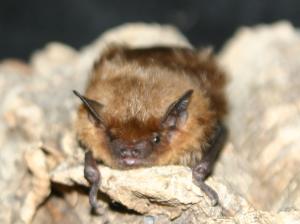February 29, 2016 | Alyssa Y

Bats sometimes get a bad rap, but these fuzzy creatures have a lot of positive things to offer! Most bats don't drink blood, and many bats love to eat fruit. Insect-eating bats eat their own body weight in insects every night! They naturally pollinate hundreds of plants around the world, spread seeds which allow plants to grow, and eat bugs at farms so that farmers don't have to use as many pesticides.
However, bats have had a difficult time lately, and many North American bat colonies have been devastated by white-nose syndrome, a disease caused by a white fungus on affected bats' wings and noses.
You can learn more about bats and white-nose syndrome by checking out the resources below.
Additionally, you can visit the Organization for Bat Conservation to learn how to #savethebats, and you can even visit the Bat Zone at their new, expanded home to see live bats, sloths, flying squirrels, and more!
[Photo of a local big brown bat courtesy of the Organization for Bat Conservation]
Suggested Reads for Kids
Little brown bats are the most common type of bat in Michigan.
Describes the work done by scientists to identify the white-nose syndrome involved in the deaths of large numbers of little brown bats in the United States and their effort to control and eradicate the disease in the future.
Explores the diverse world of bats while explaining the characteristics and behaviors of varieties ranging from the giant flying fox to the tiny bumblebee bat.
Bored with another normal, inky evening, bats discover an open library window and fly in to enjoy the photocopier, water fountain, and especially the books and stories found there.










